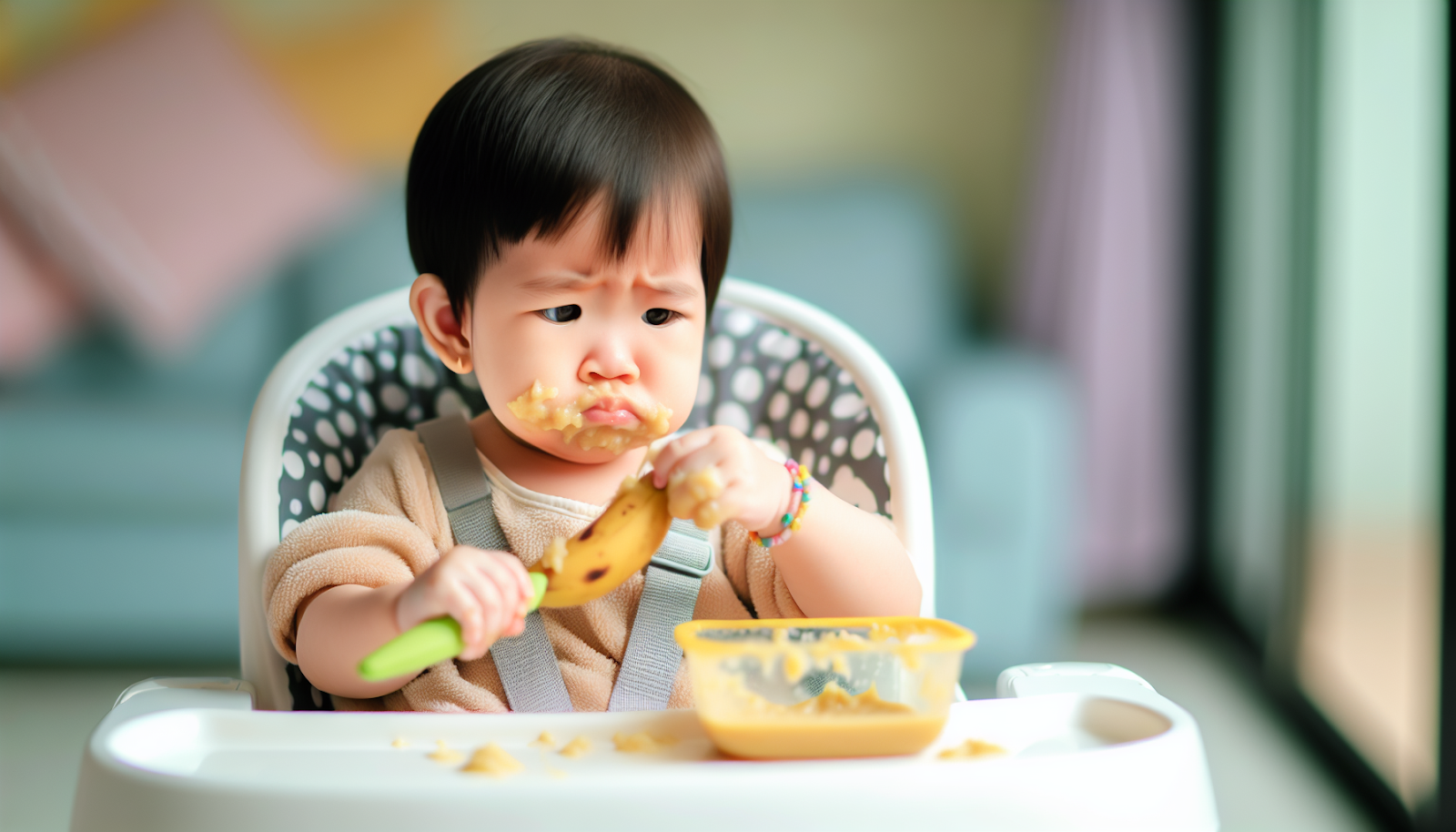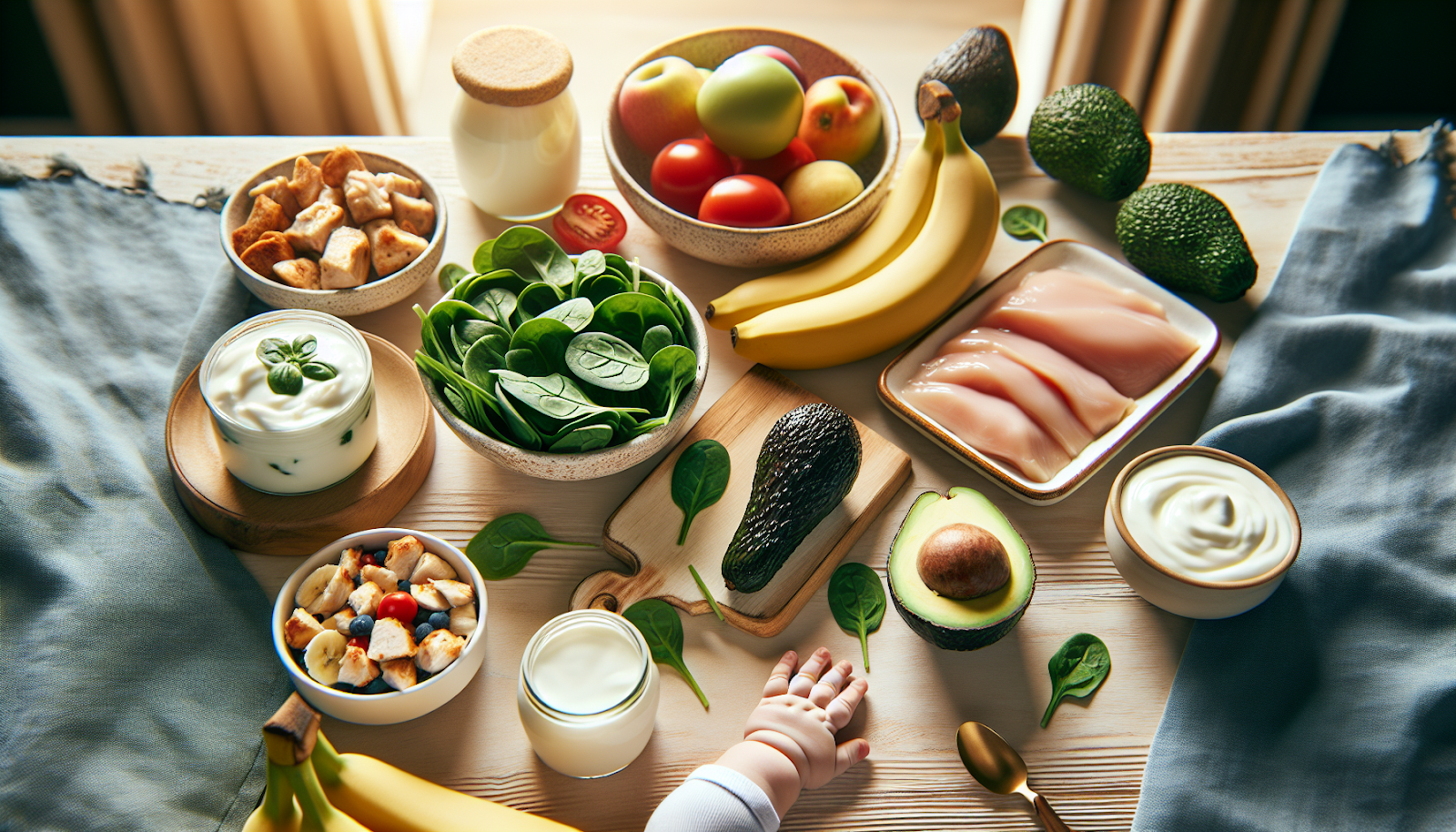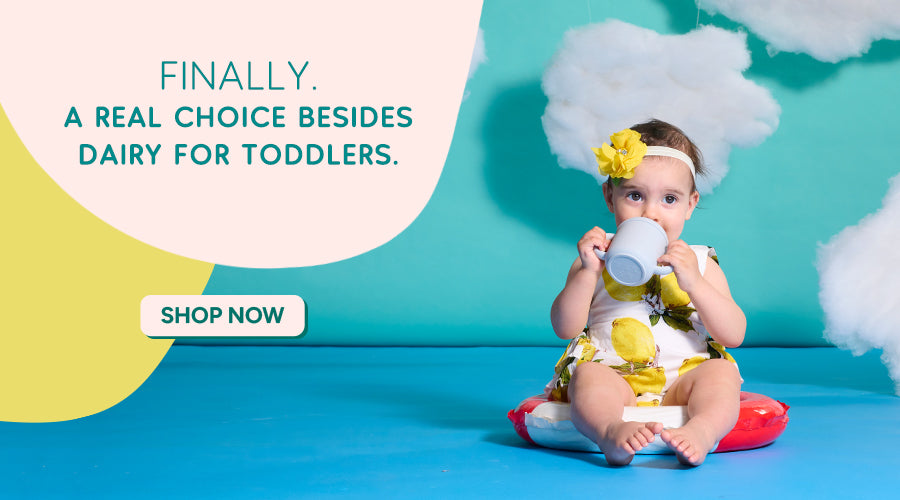
Embarking on Baby Led Weaning (BLW)? This natural, infant-led approach to introducing solids puts your baby at the heart of mealtime decisions, encouraging self-regulation and a playful introduction to foods.
Our comprehensive guide demystifies BLW, giving you the knowledge to confidently support your baby’s exploration of new tastes and textures. Ready for a weaning approach that may just change meal times for the better? Let’s get started.
Key Takeaways
- BLW (Baby Led Weaning) empowers infants to explore and self-feed , developing their motor skills by supporting hand-eye coordination and chewing skills and allowing them to experience the textures and flavors potentially influencing their food preferences and eating habits positively in the long run.
- Most babies are ready for BLW around 6 months, when they can sit unassisted and show interest in food; continue breast milk or infant formula as the main nutrition during the transition to solids.
- To safely practice BLW, ensure your baby is upright in a high chair, introduce soft and mashable foods to avoid choking, and observe your baby’s cues to assess their progress and respect their appetite.
Decoding Baby Led Weaning
Imagine your baby reaching out for a strip of well-cooked carrot, studying it curiously, and then slowly bringing it to their mouth. It’s not just about eating; it’s a learning experience! So, when should you start baby led weaning? The best time is when your baby is ready and showing interest in solid foods.
The philosophy of BLW emphasizes independence and control. It allows babies to develop crucial skills for taking food into their mouth, moving it around, and swallowing safely.
Plus, it’s a great way to introduce your baby to the textures and flavors of the family meals,reducing the need for special baby meals simplifying meal preparation. It’s a win-win for everyone!
The Right Time to Embark on Baby Led Weaning
It’s fascinating to watch your baby reach out for food or utensils and try to bring them to their mouth. These are telltale signs that your little one is ready for the leap into solid foods.
What about breast milk or formula? Don’t worry, these will continue to be your baby’s main source of nutrition as you introduce solids. Is. And, teeth or no teeth, your baby can use their gums to chew soft foods. It’s all about gradual and enjoyable transition.
Essential Steps to Initiate Baby Led Weaning
Eager to begin? Here are key steps to initiate BLW. This includes preparing your kitchen, choosing the right foods, and observing your baby’s progress.
You’ll be surprised how these simple, thoughtful steps can make your journey smoother and more enjoyable.
Preparing Your Kitchen for BLW
Before introducing food, it’s important to prepare your kitchen. During baby-led weaning, it is safest for your baby to eat in a highchair to prevent choking hazards and promote good eating habits.
This provides a secure and supportive environment for your baby during mealtimes. It keeps them upright and comfortable, which is essential for a positive eating experience. Position the highchair in a safe and convenient spot where you can easily supervise.
While BLW is a fun and engaging process, it can be a bit messy. But hey, who said messiness can’t be managed? Here are some tips to make clean-up a breeze:
- Feed your baby in just a diaper
- Use wipeable bibs
- Then, use a silicone suction bowl
- At the end, use a washable splash mat
After all, a stress-free environment contributes to a happier weaning journey!
Choosing the Right Foods for BLW
It’s important to select suitable baby led weaning foods for your baby’s BLW adventure. You want to make sure the foods are soft, mashable, and easy to handle.
Think ripe bananas, cooked carrots, slices or cubes of avocado, or soft, tender meats. These foods not only provide necessary nutrients but also help your baby explore different textures.
Remember, safety comes first! Hard, sticky, or crunchy foods could pose a choking hazard. So, it’s best to avoid these, as well as added salt, sugar, honey, and overly slippery foods in the initial stages of BLW.
Ana Reisforf, MS & RD provides her list of recommended foods for baby led weaning in this article.
Transitioning in Textures and Tastes
This gradual transition fosters proper chewing skills and helps prevent choking by utilizing the natural gag reflex. Infants who are introduced to varied textures by 9 months tend to have fewer feeding issues and better food acceptance later.
Start by thickening purees, followed by introducing lumpy, mashed, and soft minced foods, in no set order.
While transitioning, it’s essential to introduce solid foods, providing nutritional variety and encouraging exploration through playing with food. This not only fuels your baby’s curiosity but also ensures no nutritional gaps in their diet.
Monitoring and Encouraging Progress
During the baby led feeding process, keep track of your baby’s progress and respond to their hunger and satiety signals. If your little one starts looking away or throwing food on the floor, they might be telling you they’re full.
Respecting these cues encourages self-regulation by controling their food intake independently.
There might be times when your baby gags during self-feeding. If it happens, check the food size or consistency is age-appropriate and avoid foods that pose a choking hazardsuch as whole grapes, hard foods, or sticky foods like peanut butter.
Apart from this, look out for cues that your baby is ready to play. This could help enhance mealtime with interactive and positive social experiences.
Advantages of a Baby Led Approach to Weaning

What makes BLW a desirable option? Apart from the joy of watching your baby explore foods, BLW is packed with benefits that contribute to your child’s development.
Through the action of self-feeding, your baby develops fine motor skills and oral development. It’s not just about filling their tummy; it’s about equipping them with skills for life!
One of the significant advantages of BLW is that it aids energy self-regulation. As your baby learns to adjust food intake based on their hunger and fullness cues, it can lower the risk of obesity later in life.
Plus, the exposure to different tastes and textures promotes a varied diet and a healthy relationship with food.
By allowing your baby to choose the timing and types of foods consumed, you’re fostering their independence in eating habits.
Common Concerns and How to Address Them
Despite the numerous advantages of BLW, it’s natural to harbor some worries. One of the major worries is choking. To prevent this, ensure your baby is always seated upright when eating and serve well-cooked food in manageable sizes.
Knowing first aid techniques for helping babies in case of choking, can also provide reassurance.
Nutrition is another common concern. Is your baby getting enough nutrients? By incorporating a varied nutritious foods, you can ensure your baby receives all the necessary nutrients for healthy growth.
And what about the mess? Well, a few practical strategies, like feeding the baby in a diaper and using wipeable bibs and BPA-free silicone bowls, can make clean-up much simpler.
With the right approach, you can address these concerns and create a positive BLW experience.
Diverse and Healthy First Foods for BLW

When starting this journey, prioritize introducing a range of nutritious initial foods. Iron-rich foods like red meats, beans, and lentils are crucial for optimal growth and brain development.
Introducing non-sweet vegetables like broccoli and spinach, nutrient-rich and easy to grasp, sweet potatos, encourage a diverse palate and provide key nutrients. Soft fruits, dairy products, and proteins add to the nutritional mix, providing calcium, protein, and fats.
As complementary foods, introduce finger foods for easy self-feeding, such as healthy foods like solid food options:
- full-fat Greek yogurt
- cheese
- cucumbers
- cooked carrots
- banana spears
The goal is to offer a variety of textures, tastes, and nutrients for a balanced diet.
Navigating Potential Allergic Reactions
The introduction of new foods also involves dealing with potential allergic reactions. It’s advisable to introduce common food allergens such as:
- eggs
- milk
- peanuts
- tree nuts
- fish
- shellfish
- soy
- wheat
before your baby’s first birthday to help establish tolerance. Start with small quantities after beginning solids, introduce one new allergen at a time, and opt for whole, natural foods over commercial allergen products.
After allergens are introduced, regularly including them in your baby’s diet is crucial to maintain tolerance. Parents should be vigilant for signs of allergic reactions, such as skin rash, diarrhea, or vomiting.
Do seek guidance from healthcare providers, especially if your baby has a family history of allergies or specific conditions like cow’s milk allergy or severe eczema.
Cultivating a Happy and Confident Eater
BLW extends beyond just introducing new foods; it’s about fostering a joyful and self-assured eater. Establishing a consistent mealtime routine in a designated area clear of toys and distractions allows your baby to focus on eating.
Responding attentively to your baby’s eating cues, such as hunger signs or fullness indicators, creates a positive eating environment.
Including your baby in family meals enhances their learning and encourages them to try new tastes and textures. Allowing your baby to control their eating process fosters their independence and confidence in eating, an integral part of BLW.
After all, BLW is about nurturing a positive relationship with food!
Making Meal Preparation Simpler and Safer
Amid the thrill of introducing new baby food, don’t overlook the importance of meal preparation. Utilize utensils like spoons and pre-load them to help your baby practice self-feeding with different food textures.
Cook proteins and vegetables until they are soft and easily mashed to ensure safety and nutritional adequacy.
Having frozen vegetables and potatoes available for quick meal preparation can be a lifesaver on busy days. Use glass jars or compartmentalized containers for storing prepped meals, which make heating and serving during mealtimes a breeze.
Establishing a meal prep routine, such as a dedicated cooking day, can ensure your fridge is stocked with a variety of nutrient-dense foods ready for your baby’s meals.
Tailoring BLW to Your Family's Lifestyle
One of the appealing aspects of BLW is its adaptability. You can adapt the BLW approach to fit your family meals, ensuring that your baby can eat the same foods as the rest of the family.
Resources like the Weaning with Family Meals course can help you tailor family meals to the BLW approach, covering recipe adaptations and meal planning for infants from 6 months to over a year.
BLW supports family lifestyles by:
- Making dining out simpler, as it removes the need for a separate meal for the baby, leading to less stress around mealtimes
- Enhancing family cohesion during meals
- Contributing to the baby’s development of motor skills and adaptation to a variety of tastes and textures.
Else Plant-Based Complete Toddler Nutrition is Great for Weaning
Adding a comprehensive plant-based nutrition solution to your baby’s diet can effectively complement their BLW journey. Else Nutrition offers a complete nutrition toddler drink that’s perfect for weaning. Their products are made from real, whole foods and provide necessary nutrients your baby needs.
It’s a great addition to the varied diet encouraged by BLW, offering another way to ensure your baby is getting a balanced and nutritious diet.

Frequently Asked Questions
When should you start baby-led weaning?
Introducing solids foods should start around 6 months, when your baby shows signs of readiness such as sitting up independently, when they develpoed hand-eye coordination, and showing interest in table foods. It's best to begin with one solid meal a day during family mealtime.
Do pediatricians recommend baby-led weaning?
Yes, pediatricians generally acknowledge baby-led weaning as a safe complementary feeding method that supports chewing, growth, and fine motor skill development. It's a method that is well-regarded by healthcare professionals.
What is the baby-led weaning technique?
Baby-led weaning is a method of introducing solid foods to babies, where infants self-feed finger foods instead of being spoon-fed purees, typically starting around 6 months old. It encourages self-feeding and skipping purees.
What are some good first foods for baby led weaning?
Great first foods for baby led weaning include ripe bananas, cooked carrots, avocado, sweet potatoes, and soft meats, as they are easy to handle and chew. Happy weaning!
How can I prevent choking during BLW?
To prevent choking during BLW, always seat your baby upright, serve age appropriate well-cooked food in manageable sizes, and avoid hard or sticky foods. Stay attentive and encouraging as your baby explores new tastes and textures.
The content and advice provided in this article is for informational purposes only and is not a substitute for medical diagnosis, treatment, advice for specific medical conditions. Always consult a pediatrician to understand the individual needs of your child. The article expresses the views of the brand editor.



